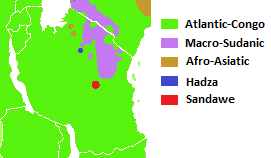|
BAKWATA
The National Muslim Council of Tanzania (BAKWATA) is a leading faith-based Islamic organisation headquartered in Kinondoni ward of Kinondoni District in Dar es Salaam Region, Tanzania. History BAKWATA registered in 1968. Organization The Council has branch offices across Tanzania with a network from the national to grassroots level with 22 regional and 169 district offices served by over 3000 sheikhs. It coordinates around 10,800 mosques. It owns around 40 acres of land in each of its 22 regions. It operates 32 secondary schools, two teachers’ colleges, 30 theological colleges, and a radio station. It supports numerous madrasas. Environmental work From the late 1990s, BAKWATA has organised and facilitated training for its Muslim scholars on environmental issues. Ongoing work on environmental issues includes: environmental education for madrasa pupils in 10 coastal districts, environmental education and management clubs in 10 secondary schools and spreading the use of ... [...More Info...] [...Related Items...] OR: [Wikipedia] [Google] [Baidu] |
Kinondoni, Kinondoni District
Kinondoni (''Kata ya Kinondoni'' in Swahili) is an administrative ward in the Kinondoni District of the Dar es Salaam Region in Tanzania. The ward is bordered to the east by Mikocheni and Mwananyamala wards, to the west by Hananasif ward, and to the north by Msasani ward. The ward is home to the headquarters for the National Muslim Council of Tanzania (BAKWATA) with its grand Mosque. The ward is also the headquarters of Tanzania's second largest political party Chadema. According to the 2012 census, the ward has a total population of 21,239. Administration The postal code for Kindondoni ward is ''14110''. The ward is divided into the following neighborhoods (''Mitaa''): * Ada Estate * Kinondoni Mjini * Kinondoni Shamba * Kumbukumbu Government The ward, like every other ward in the country, has local government offices based on the population served.''The Kinondoni Ward'' administration building houses a court as per the Ward Tribunal Act of 1988, including other vital departm ... [...More Info...] [...Related Items...] OR: [Wikipedia] [Google] [Baidu] |
Kinondoni District, Dar Es Salaam
Kinondoni District, officially the Kinondoni Municipal Council (''Halimashauri ya Manispaa ya Kinondoni'', in Swahili) is one of five districts of the Dar es Salaam Region of Tanzania. The district is bordered to the north by Bagamoyo District and Kibaha of Pwani Region, to the east by the Indian Ocean, the west by Ubungo District, and to the south by the Ilala District. The district covers an area of . The district is comparable in size to the land area of Malta. The administrative seat is Ndugumbi. The district is home to one of the best preserved Medieval Swahili settlements, Kunduchi Ruins, headquarters for the National Muslim Council of Tanzania (BAKWATA) and Makumbusho Village Museum. Considered the cultural center of Dar es Salaam, Kinondoni District is also regarded the birthplace of the musical genre of Singeli. In addition the district is one of two districts in Dar es Salaam that has a National Historic Site, namely the Kunduchi Ruins. The 2012 National Tanzani ... [...More Info...] [...Related Items...] OR: [Wikipedia] [Google] [Baidu] |
Kinondoni District
Kinondoni District, officially the Kinondoni Municipal Council (''Halimashauri ya Manispaa ya Kinondoni'', in Swahili language, Swahili) is one of five Districts of Tanzania, districts of the Dar es Salaam Region of Tanzania. The district is bordered to the north by Bagamoyo District and Kibaha of Pwani Region, to the east by the Indian Ocean, the west by Ubungo District, and to the south by the Ilala District. The district covers an area of . The district is comparable in size to the land area of Malta. The administrative seat is Ndugumbi. The district is home to one of the best preserved Medieval Swahili settlements, Kunduchi Ruins, headquarters for the National Muslim Council of Tanzania (BAKWATA) and Makumbusho Village Museum. Considered the cultural center of Dar es Salaam, Kinondoni District is also regarded the birthplace of the musical genre of Singeli. In addition the district is one of two districts in Dar es Salaam that has a National Historic Sites of Tanzania, National ... [...More Info...] [...Related Items...] OR: [Wikipedia] [Google] [Baidu] |
Dar Es Salaam Region
Dar es Salaam Region () is one of Tanzania's 31 administrative regions and is located on the east coast of the country. The region covers an area of . The region is comparable in size to the combined land and water areas of the nation state of Mauritius. Dar es Salaam Region is bordered to the east by the Indian Ocean and is entirely surrounded by Pwani Region. The Pwani districts that border Dar es Salaam region are Bagamoyo District to the north, Kibaha Urban District to the west, Kisarawe District to the southwest and Mkuranga District to the south of the region. The region's seat (capital) is located inside the ward of Ilala. The region is named after the city of Dar es Salaam itself. The region is home to Tanzania's major finance, administration and industries, thus the making it the country's richest region. The region also has the second highest Human Development Index in the country after Mjini Magharibi. According to the 2022 census, the region has a total populatio ... [...More Info...] [...Related Items...] OR: [Wikipedia] [Google] [Baidu] |
Tanzania
Tanzania, officially the United Republic of Tanzania, is a country in East Africa within the African Great Lakes region. It is bordered by Uganda to the northwest; Kenya to the northeast; the Indian Ocean to the east; Mozambique and Malawi to the south; Zambia to the southwest; and Rwanda, Burundi, and the Democratic Republic of the Congo to the west. According to a 2024 estimate, Tanzania has a population of around 67.5 million, making it the most populous country located entirely south of the equator. Many important hominid fossils have been found in Tanzania. In the Stone and Bronze Age, prehistoric migrations into Tanzania included South Cushitic languages, Southern Cushitic speakers similar to modern day Iraqw people who moved south from present-day Ethiopia; Eastern Cushitic people who moved into Tanzania from north of Lake Turkana about 2,000 and 4,000 years ago; and the Southern Nilotic languages, Southern Nilotes, including the Datooga people, Datoog, who originated fro ... [...More Info...] [...Related Items...] OR: [Wikipedia] [Google] [Baidu] |
Swahili Language
Swahili, also known as as it is referred to endonym and exonym, in the Swahili language, is a Bantu languages, Bantu language originally spoken by the Swahili people, who are found primarily in Tanzania, Kenya, and Mozambique (along the East African coast and adjacent littoral islands). Estimates of the number of Swahili speakers, including both native and second-language speakers, vary widely. They generally range from 150 million to 200 million; with most of its native speakers residing in Tanzania and Kenya. Swahili has a significant number of loanwords from other languages, mainly Arabic, as well as from Portuguese language, Portuguese, English language, English and German language, German. Around 40% of Swahili vocabulary consists of Arabic loanwords, including the name of the language ( , a plural adjectival form of an Arabic word meaning 'of the coasts'). The loanwords date from the era of contact between Arab slave trade, Arab traders and the Northeast Bantu languages, B ... [...More Info...] [...Related Items...] OR: [Wikipedia] [Google] [Baidu] |
Classical Arabic
Classical Arabic or Quranic Arabic () is the standardized literary form of Arabic used from the 7th century and throughout the Middle Ages, most notably in Umayyad Caliphate, Umayyad and Abbasid Caliphate, Abbasid literary texts such as poetry, elevated prose and oratory, and is also the liturgical language of Islam, "Quranic" referring to the Quran. Classical Arabic is, furthermore, the Register (sociolinguistics), register of the Arabic language on which Modern Standard Arabic is based. Several written grammars of Classical Arabic were published with the exegesis of Arabic grammar being at times based on the existing texts and the works of previous texts, in addition to various early sources considered to be of most venerated genesis of Arabic. The primary focus of such works was to facilitate different linguistic aspects. Modern Standard Arabic is its direct descendant used today throughout the Arab world in writing and in formal speaking, for example prepared speeches, some r ... [...More Info...] [...Related Items...] OR: [Wikipedia] [Google] [Baidu] |
Languages Of Tanzania
Tanzania is a multilingual country. There are many languages spoken in the country, none of which is spoken natively by a majority or a large plurality of the population. Swahili and English, the latter being inherited from colonial rule (''see Tanganyika Territory''), are widely spoken as lingua francas. They serve as working languages in the country, with Swahili being the official national language. There are more speakers of Swahili than English in Tanzania. Overview According to ''Ethnologue'', there are a total of 126 languages spoken in Tanzania. Two are institutional, 18 are developing, 58 are vigorous, 40 are endangered, and 8 are dying. There are also three languages that recently became extinct. Most languages spoken locally belong to two broad language families: Niger-Congo ( Bantu branch) and Nilo-Saharan ( Nilotic branch), spoken by the country's Bantu and Nilotic populations, respectively. Additionally, the Hadza and Sandawe hunter-gatherers speak languag ... [...More Info...] [...Related Items...] OR: [Wikipedia] [Google] [Baidu] |
Chief Mufti
A mufti (; , ) is an Islamic jurist qualified to issue a nonbinding opinion (''fatwa'') on a point of Islamic law (''sharia''). The act of issuing fatwas is called ''iftāʾ''. Muftis and their ''fatāwa'' have played an important role throughout Islamic history, taking on new roles in the modern era. Tracing its origins to the Quran and early Islamic communities, the practice of ''ifta'' crystallized with the emergence of the traditional legal theory and schools of Islamic jurisprudence (''madhahib''). In the classical legal system, fatwas issued by muftis in response to private queries served to inform Muslim populations about Islam, advise courts on difficult points of Islamic law, and elaborate substantive law. In later times, muftis also issued public and political fatwas that took a stand on doctrinal controversies, legitimized government policies or articulated grievances of the population. Traditionally, a mufti was seen as a scholar of upright character who possessed ... [...More Info...] [...Related Items...] OR: [Wikipedia] [Google] [Baidu] |






